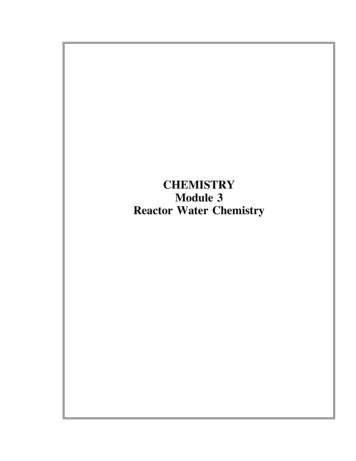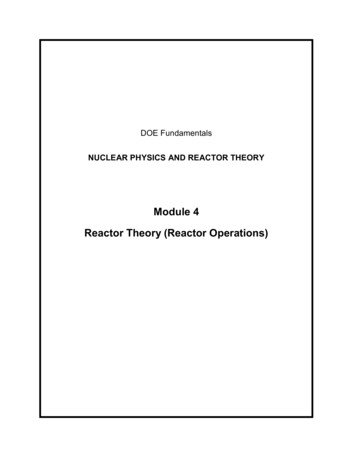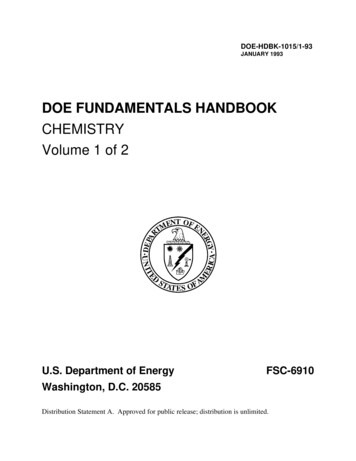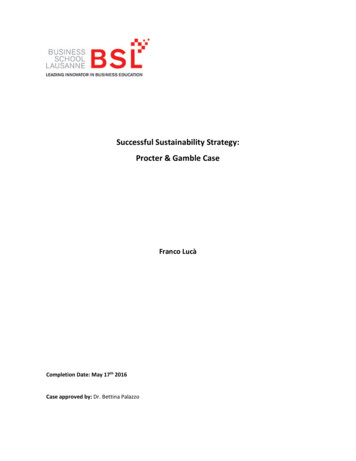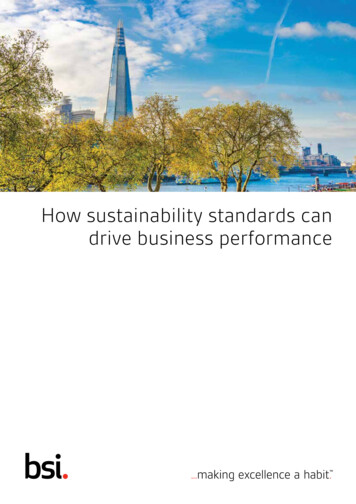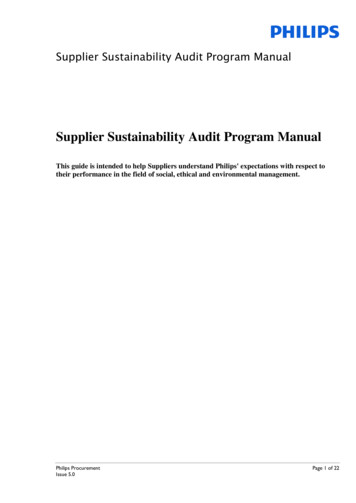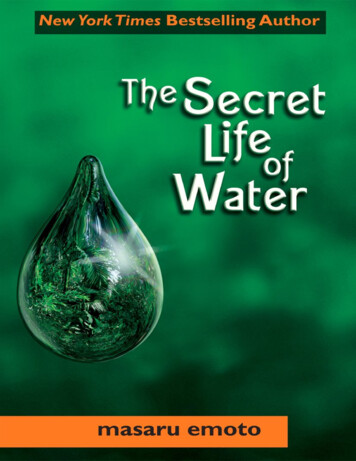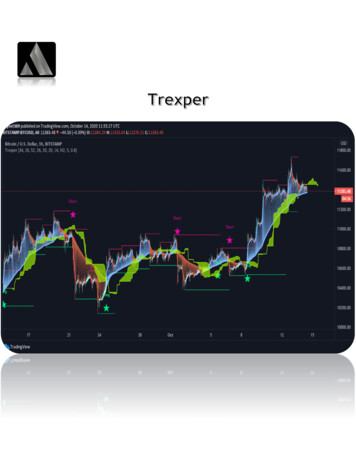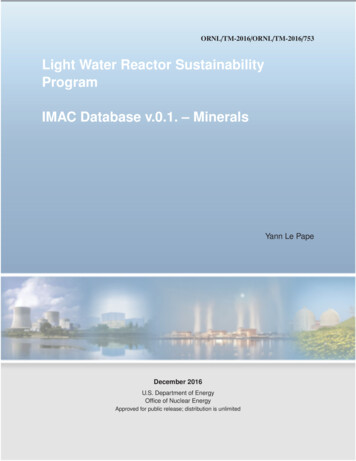
Transcription
ORNL/TM-2016/ORNL/TM-2016/753Light Water Reactor SustainabilityProgramIMAC Database v.0.1. – MineralsYann Le PapeDecember 2016U.S. Department of EnergyOffice of Nuclear EnergyApproved for public release; distribution is unlimited
DOCUMENT AVAILABILITYReports produced after January 1, 1996, are generally available free via US Department of Energy(DOE) SciTech Connect.Website: http://www.osti.gov/scitech/Reports produced before January 1, 1996, may be purchased by members of the publicfrom the following source:National Technical Information Service5285 Port Royal RoadSpringfield, VA 22161Telephone: 703-605-6000 (1-800-553-6847)TDD: 703-487-4639Fax: 703-605-6900E-mail: info@ntis.fedworld.govWebsite: http://www.ntis.gov/help/ordermethods.aspxReports are available to DOE employees, DOE contractors, Energy Technology Data Exchange representatives, and International Nuclear Information System representatives from thefollowing source:Office of Scientific and Technical InformationPO Box 62Oak Ridge, TN 37831Telephone: 865-576-8401Fax: 865-576-5728E-mail: report@osti.govWebsite: http://www.osti.gov/contact.htmlThis report was prepared as an account of work sponsored by anagency of the United States Government. Neither the United StatesGovernment nor any agency thereof, nor any of their employees, makesany warranty, express or implied, or assumes any legal liability orresponsibility for the accuracy, completeness, or usefulness of anyinformation, apparatus, product, or process disclosed, or representsthat its use would not infringe privately owned rights. Reference hereinto any specific commercial product, process, or service by trade name,trademark, manufacturer, or otherwise, does not necessarily constituteor imply its endorsement, recommendation, or favoring by the UnitedStates Government or any agency thereof. The views and opinions ofauthors expressed herein do not necessarily state or reflect those ofthe United States Government or any agency thereof.
ORNL/TM-2016/ORNL/TM-2016/753Light Water Reactor Sustainability ProgramFusion and Materials for Nuclear Systems DivisionIMAC Database v.0.1. – R0403044Yann Le PapeDecember 2016Prepared byOAK RIDGE NATIONAL LABORATORYP.O. Box 2008Oak Ridge, Tennessee 37831-6285managed byUT-Battelle, LLCfor theUS DEPARTMENT OF ENERGYOffice of Nuclear Energyunder contract DE-AC05-00OR22725
CONTENTSLIST OF FIGURES . . . . . . . . . . . . . . . . . . . . . . . . . . . . . . .LIST OF TABLES . . . . . . . . . . . . . . . . . . . . . . . . . . . . . . .ACRONYMS . . . . . . . . . . . . . . . . . . . . . . . . . . . . . . . . . .1. CONTEXT . . . . . . . . . . . . . . . . . . . . . . . . . . . . . . . . .2. MOTIVATIONS AND OBJECTIVES . . . . . . . . . . . . . . . . . . .3. DEVELOPMENT TOOLS . . . . . . . . . . . . . . . . . . . . . . . . .4. CURRENT DEVELOPMENT STATUS . . . . . . . . . . . . . . . . . .5. PRELIMINARY INTERPRETATION OF THE RIVE DATA . . . . . . .6. FY2017 DEVELOPMENT SCHEDULE . . . . . . . . . . . . . . . . . .APPENDIX . . . . . . . . . . . . . . . . . . . . . . . . . . . . . . . . . . .A AGGREGATES AND MINERALS HIERACHICAL CLASSIFICATIONiii.Page. v. vii. ix. xi. xii. xiv. xvi. xvii. xx.xxiii.xxiii
LIST OF FIGURESFigures1Risk-assessment of the irradiation effects on concrete and theirs structural significance.DOE LWRS Strategy. . . . . . . . . . . . . . . . . . . . . . . . . . . . . . . . . . . . .2Feldspar ternary diagram (sodium-calcium–potassium). ( ) indicates minerals for whichradiation-induced volumetric expansion (RIVE) data are available. Ab: albite, An:anorthite, Andes: andesine, Ano: anorthoclase, Byt: bytownite, Lab: labradorite, Mc:microcline, Olg: oligoclase, Sa: sanidine . . . . . . . . . . . . . . . . . . . . . . . . . .3Scatter plot (plagioclase). ( ): Mean calculated expansions, i.e., ε̃ . ( ): albite; ( ):labradorite; ( ): oligoclase: Calculated expansions assuming the mean values of the best-fitparameters. ( ): expansion at mean temperature (model ZD only). Vertical bar: min./max.calculated expansions (temperature uncertainties). Dashed lines: model error at a 90%interval confidence (See equation provided in upper-left corner of the plot). . . . . . . .4ASTM C294 hierarchical classification of aggregate used in concrete. The ramificationextremities show the possible minerals constitutive of the rocks. . . . . . . . . . . . . .5Hierarchical classification of silicates (non exhaustive list). (*) indicates available dataobtained by ion-beam irradiation, i.e., critical amorphization dose; (**) corresponds toavailable data obtained by neutron irradiation. . . . . . . . . . . . . . . . . . . . . . . .vPage. . xii. . xvii. .xviii. . xxiv. . xxv
LIST OF TABLESTablesPage(†)1Plagioclases: Best-fit parameters, regression coefficients and errors. :nE 10 keV .pm 2 C 1 , (‡) : nE 10 keV .pm 2 , ( ) : K. ε̃ 90% ε err . . . . . . . . . . . . . . . . xixvii
ACRONYMSASRalkali-silica reactionBASH Bourne-again shellCBSconcrete biological shieldhcphardened cement pasteHLWhigh-level wasteIMAC Irradiated Minerals, Aggregates and ConcreteKJMA dt algorithmLWRlight water reactorLWRS Light Water Reactor SustainabilityMDmolecular dynamicsmXRF micro X-ray fluorescenceORNL Oak Ridge National LaboratoryQAquality assuranceRIVEradiation-induced volumetric expansionTEMTransmission Electron MicroscopyVCSversion control systemXMLExtensible Markup Languageix
1.CONTEXTLight water reactors (LWRs) concrete biological shields (CBSs) are exposed to high neutrons and gammairradiations [Fukuya et al., 2002, Esselman and Bruck, 2013, Remec et al., 2016] potentially reaching levelsfor which degradation has been reported in the literature, i.e., 5 1018 n.cm 2 at E 0.1 MeV [Hilsdorfet al., 1978, Seeberger and Hilsdorf, 1982]. Reviews of current knowledge on irradiated concrete can befound in [Willam et al., 2013, Rosseel et al., 2016]. At 80 years of operation, it is estimated that thebounding fluence approaches 6 1019 nE 0.1 MeV .cm 2 , i.e., about 12 times, the potentially critical dose forirradiation-induce damage onset (As countries other than the U.S. may consider different operation extensionperiods, the bounding fluence can be estimated proportionally). Susceptibility of concrete to neutronirradiation greatly varies as a function of its constituents, i.e., coarse aggregates, sand, and hardened cementpaste (hcp). In particular, higher irradiation-susceptibility was found as a direct function of aggregates RIVE[Elleuch et al., 1972, Field et al., 2015, Le Pape et al., 2015], i.e., the propensity of swelling as a function oftheir minerals contents, structures and textures. Irradiation-induced amorphization, also referred to asmetamictization when occurring naturally by α-decay in rocks bearing U, Th. . . , also induces significantdensity change, especially in silicates. For example, the maximum volumetric expansion of quartz andfeldspars – a group of rock-forming tectosilicate minerals that make up as much as 60% of the Earth’s crust[Clarke and Washington, 1924, Wedepohl, 1971] – has been shown to be as large as 18% [Primak, 1958,Zubov and Ivanov, 1966] and 8% [Krivokoneva, 1976], respectively, while the change of density in calciteremains rather low ( 0.3% according to [Wong, 1974]) Depending on the mineralogical content,considerable variations in aggregate RIVE [Dubrovskii et al., 1967, Kelly et al., 1969, Dubrovskii et al.,1970, Seeberger and Hilsdorf, 1982] have been observed as described in the comprehensive review by Fieldet al. [2015]. Moreover, some observed post-irradiation expansions exceed what is considered as detrimentalby alkali-silica reaction (ASR) researchers (e.g., [Fournier and Bérubé, 2000, Rajabipour et al., 2015]).Because the CBS structural concrete is made of 70% of aggregates by volume, RIVE imposes severestresses on the surrounding hcp leading to micro-cracking, or even fracturing [Le Pape et al., 2015, Giorlaet al., 2016]. Because, for obvious economical reasons, the concrete used for the construction of any nuclearpower plants structures is made with local materials, large variations of mineralogical composition ofaggregate are expected causing major differences in terms of susceptibility against irradiation. Hence, thesignificance of irradiated structure depends directly on its constituents, and in particular on theaggregate-forming minerals composition, texture and volume fraction.xi
2.MOTIVATIONS AND OBJECTIVESThe DOE LWRS Program Materials and Aging Degradation Pathway has developed a holistic approach,based on materials characterization and modeling, to assess the susceptibility of concrete against irradiationeffects and the structural significance of irradiated concrete biological shield in light water reactors (LWRs). –Fig. Figure 1. This approach aims at using experimental data collected in test reactors, and possibly afterharvesting from in-service reactor, to help the development and the validation of irradiated concrete modelsto be utilized for the structural assessment of any specific LWR CBS.The development of a materials database is central in order to:1. Connect materials characterization and modeling tools with reliable irradiated properties;2. Facilitate data searching for correlation analysis;3. Validate irradiated concrete models, in particular, upscaling models (micromechanics ormeso/micro-scale numerical models), i.e, minerals aggregate concrete; and,4. Assess the susceptibility of a specific aggregate or concrete against irradiation.Figure 1. Risk-assessment of the irradiation effects on concrete and theirs structural significance. DOE LWRS Strategy.A number of irradiated concrete and aggregate properties (compressive and tensile strength, Young modulus,loss of mass and radiation-induced expansion) have been previously collected [Field et al., 2015]. Althoughlikely-silicate-bearing aggregates were found to be more RIVE-prone than likely-carbonate-bearingaggregates, it appears that the ASTM classification[ASTM C294-12] of aggregates for concrete fails to definexii
the resistance of aggregates against neutron irradiation. Typical examples can be found in Gray [1971] wheredifferent aggregates categorized as limestone, i.e, primarily carbonated rocks, exhibit very low expansions, asexpected for carbonates, to high linear expansions 1%. The lack of information on the detailedmineralogical contents result in inherent limitations when interpreting the data, in particular, with regard tothe large observed scatter. Moreover, the representativity of irradiated aggregate or concrete data against theactual concrete composition used for CBS is more difficult to assess.Hence, to develop a more rational classification of irradiation-sensitive aggregate, the Light Water ReactorSustainability (LWRS) Program approach is to adopt a “bottom-to-top” methodology aiming atcharacterizing irradiated mineral analogues, as a first step, before studying irradiated aggregates. i.e.,understanding and modeling the interactions between rock-forming minerals, in a second step, and finally,address irradiated concrete using tools previously developed [Le Pape et al., 2015, Giorla et al., 2015, 2017].Numerous neutron-irradiated minerals RIVE are scattered in the public ’Western’ literature, e.g., [Wittels,1957, Primak, 1958, Wong, 1974, Seeberger and Hilsdorf, 1982]. . . along with on-going irradiated mineralsanalogues study at Oak Ridge National Laboratory (ORNL) [Rosseel, 2016]. In addition, more recently,Russian literature was made available to the LWRS Program researchers. These data are extremely valuableas varied minerals, aggregates formed with similar minerals, and concrete made with the same aggregatewere tested in similar irradiation conditions. It must also be noted that past research programs related tohigh-level waste (HLW) storage resulted in the publication of data on the resistance of minerals againstion-irradiation [Eby et al., 1992, Dran et al., 1992]. More recently, electron-irradiation amorphization ofminerals was also studied [Muto and Maruyama, 2016]).However, limited data on irradiated elastic properties are still available: all elastic tensor constants, c i j ,[Mayer and Gigon, 1956, Mayer and Lecomte, 1960, Zubov and Ivanov, 1967] are available for irradiatedquartz only. On-going experiments of mineral analogues aims at providing elastic properties for otherminerals. It must also be said that molecular dynamics (MD) can help estimate RIVE amplitude and the c i jconstants of irradiated minerals (in particular, where data is missing), although, some uncertainties about theenergy potential in complex crystalline system limit the use of these results.Finally, the experimental characterization of rock-forming minerals in concrete aggregate using, for examplemicro X-ray fluorescence (mXRF) and petrographic analysis, requires elements and oxides compositionsdata.The Irradiated Minerals, Aggregates and Concrete (IMAC) database aims a collecting all the aforementionedscattered information and data using a systematic approach, including the use of publicly available standardformat to export the database and the documentation of the original sources. The database development toolsand schedule are provided in sections 3. and 6., respectively.xiii
3.DEVELOPMENT TOOLSThe IMAC database is currently hosted on an internal server at ORNL:https://code-int.ornl.gov/ylb/IMAC database. Access is currently limited to a small number ofdevelopers. However, a public release is envisioned for Summer 2017. For the sake of increased qualityassurance (QA), the database is being developed and managed by GitLab https://about.gitlab.com/,a web-based version control system (VCS) Git https://git-scm.com/ repository manager with wiki andissue tracking features, using an open source licence. Any committed change, i.e., addition/modification ofnew/existing data and features, is tracked and recorded. The database uses primarily Scilabhttp://www.scilab.org/, a free open source software for numerical computation, similar to MathLab,to:1. Input and structure data in the database,2. Export the database in Extensible Markup Language (XML) files to allow the use of the third-partiessoftware such as finite element code, and,3. Export the database in LATEX-format automatically-generated documentation.The data structures generated in Scilab can advantageously be utilized by upscaling micromechanics-typeanalysis, e.g, [Le Pape et al., 2015]: minerals aggregate concrete.The IMAC repository currently includes the following folders:bib contains the bibliographic database IMAC.bib, using BiBTEX reference management software(http://www.bibtex.org/ – For the sake of convenience, the installation of a graphical applicationfor managing BiBTEX files is recommended: e.g., JabRef, http://www.jabref.org/, an opensoftware using Java). Whenever accessible, copies of the original data sources, i.e., journal articles,proceedings, and sometimes books, are stored in bib/pdf. This feature allows future verification ofanomalous or suspicious data. Note that BiBTEX citations entries correspond strictly to thecross-reference entries in the database .sci files to exchange information between the bibliographicdatabase and the materials databasedoc/pub contains the LATEX file IMAC database.tex necessary to compile the database in .pdf format.Note that IMAC database.pdf being automatically generated, some information can be redundant.For example, each of the 21 elastic constants data of the minerals includes the information on theexperimental technique used (In most cases, the same technique was used to derive all elastic constantsof the same mineral). That information is repeated in the exported file. The main reason for theseduplications in the .sci data files is to ensure that each data point is correctly and thoroughlyinformed in its data structure to permit efficient data search.minerals contains the minerals database per se. Each mineral corresponds to a specific folder name, e.g.,minerals/albite, containing multiples data files (generally .sci files, although some informationcan also be stored in .txt (plain text) files when appropriate, e.g., long tables or figure captions. or.png image files, for scanned figure before digitization). For each mineral, a master Scilab file loadsall information/data. The name of the master file corresponds to the folder name, i.e., the mineralnames, e.g., minerals/albite/albite.sci.XML exports also use the mineral names, e.g., minerals/albite/albite.xml.LATEX exports use the extension pub.tex, e.g., minerals/albite/albite pub.xml.scilab contains Scilab executable files need to run the database. In particular, loading the database libraryand exporting the minerals database are performed by launchingxiv
quick-screen-minerals.sce in a Scilab console, after configuring and launchingenvironment variable.sci (See config).config contains only one configuration file, environment variable.sci, to be edited by each user toprovide information about the path to the IMAC database end export options.lib contains all Scilab functions library files necessary for description of the data structures, e.g.,mineral template.sci, exports, e.g., xml export.sci. It also contains Bourne-againshell (BASH) scripts to extract some general information from publicly-accessible mineralsweb-database, e.g., mineral classification.sh.reactors contains currently one file only: list reactors.sci linking test reactor names and channelsto codes used in the database. Future developments envision to add information on the neutron fluencespectrums.xv
4.CURRENT DEVELOPMENT STATUSThe December 2016 release includes minerals data only. Currently, the IMAC database contains only 42minerals which corresponds to about 120 Mb of source code files, pdf documentation, and 72,000lines of XML output data. The number of imported mineral may seem poor compared to the 4,500different known minerals. However, it must be noted that this database is oriented toward concrete aggregate.In that regards, more than 90% on the crust is composed of silicate minerals. Most abundant silicates arefeldspars – plagioclase (approx40%) and alkali feldspar ( 10%). Other common silicate minerals are quartz( 10%) pyroxenes ( 10%), amphiboles ( 5%), micas ( 5%), and clay minerals ( 5%) [Wedepohl, 1971].The rest of the silicate family comprises 3% of the crust. Only 8% of the crust is composed of non-silicates,i.e., carbonates, oxides, sulfides. . . Although the IMAC database is subject to expansion in the future, thecurrent list of minerals covers, to a large extent, concrete aggregate-forming minerals. Minerals currentlyavailable in IMAC are albite, analcime, andesine, ankerite, anorthite, anorthoclase, augite, biotite, bromellite,bronzite, bytownite, calcite, cassiterite, chamosite, clinochlore, cordierite, corundum, diopside, dolomite,enstatite, fluorapatite, forsterite, hematite, hornblende, hydroxylapatite, labradorite, lizardite, magnesite,magnetite, microcline, muscovite, nepheline, oligoclase, orthoclase, periclase, phlogopite, pyrope, quartz,rutile, sanidine, siderite, silica (amorphous), and, spinel.xvi
5.PRELIMINARY INTERPRETATION OF THE RIVE DATAOn-going studies aims to analyze the minerals RIVE data by series or groups (e.g., Dana’s [Dana, 1892] newclassification) and provide best-fit parameters assuming two different isothermal RIVE models (S-shapedcurve – details of the equations not given here): (1) (Z) Zubov and Ivanov’s model [Zubov and Ivanov, 1966],or, (2) (N) Kolmogorov-Johnson-Mehl-Avrami (KJMA) nucleation-growth model [Kolmogorov, 1937,Johnson and Mehl, 1939, Avrami, 1939, 1940, 1941]. , in conjunction with different threetemperature-dependent RIVE models: (1) (L) linear[Le Pape et al., 2016], or, (2) (A) activation energy, or,(3) (D) Denisov’s tabulated values. . The RIVE data from the IMAC database are fitted with combinedmodels (ZL), (ZA), (NA) and (ZD) neutrons and all fluence are normalized [Denisov et al., 2012] atE 10 keV. Because of the uncertainties related to the average irradiation temperature, temperature isanalyzed as a probabilistic variable.For the sake of illustration, the analysis made on irradiated plagioclases (feldspars) is presented. Feldspars(KAlSi3 O8 - NaAlSi3 O8 - CaAl2 Si2 O8 ) are a group of rock-forming tectosilicate minerals that make up asmuch as 60% of the Earth’s crust [Clarke and Washington, 1924, Wedepohl, 1971] Feldspars crystallize inboth intrusive and extrusive igneous rocks, are also present in many types of metamorphic rock, and are alsofound in many types of sedimentary rocks. Feldspars are generally separated in two groups: plagioclase (Pl,sodium-calcium bearing minerals, triclinic) and alkali feldspar, also known as potash feldspars, or K-feldspar(Kfs, sodium-potassium bearing minerals, triclinic or monoclinic). The two groups meet at the high-sodiumend-members, i.e., albite (Ab), oligoclase (Olg) and anorthoclase (Ano) – Figure 2. The regression modelFigure 2. Feldspar ternary diagram (sodium-calcium–potassium). ( ) indicates minerals forwhich RIVE data are available. Ab: albite, An: anorthite, Andes: andesine, Ano: anorthoclase,Byt: bytownite, Lab: labradorite, Mc: microcline, Olg: oligoclase, Sa: sanidineresults for plagioclases expansions are presented in the scatter plots Figure 3 and in Table 1. The most reliableexpansion model was found to be model (ZA) with r2 0.96 and a 90% confidence intervale error of 0.76%.Similar on-going analysis are being performed on other silicates and carbonated groups. These mineralsRIVE models will be used in subsequent analysis/modeling of the irradiated aggregates to be implemented inphase 2 (v0.2) of the IMAC database.xvii
(a) Model (ZL).(b) Model (ZA).(c) Model (NA).(d) Model (ZD).Figure 3. Scatter plot (plagioclase). ( ): Mean calculated expansions, i.e., ε̃ . ( ): albite; ( ):labradorite; ( ): oligoclase: Calculated expansions assuming the mean values of the best-fit parameters. ( ): expansion at mean temperature (model ZD only). Vertical bar: min./max. calculated expansions (temperature uncertainties). Dashed lines: model error at a 90% intervalconfidence (See equation provided in upper-left corner of the plot).xviii
Table 1. Plagioclases: Best-fit parameters, regression coefficients and errors.(‡) : nE 10 keV .pm 2 , ( ) : K. ε̃ 90% ε errmodelparametersa(†)b(‡)LL0.0173 (39%) -0.7672 (51%) 0.0330 (20%) -0.1765 (386%)Φc (‡)Ea,c /R ( )ΦL (‡)Ea,L /R ( )0.1451 (66%) 3728 (44%)1.6110 (16%) 2118 (18%)Φc (‡)d(#)Ea,c /R ( )1.7034 (20%) 9.3311 (164%) 2172 (17%)Tabulated values in Denisov’s et al.a(†)c(ZL)(ZA)(NA)(†) :nE 10 keV .pm 2 C 1 ,err Δε .47%0.79b(‡)c(ZD)The interpretation of highly-valuable data from the Russian literature provide new perspectives on irradiatedminerals and guidance on the susceptibility of aggregates against irradiation: The susceptibility (ε max ) of silicates against neutron-irradiation can be ranked as follows: quartz( 18%) feldspar ( 8%) pyroxene ( 3%). Due their nearly perfect basal cleavage, micas RIVEdata are subject to large uncertainties. The susceptibility (ε max ) of carbonates against neutron-irradiation, much lower than for silicates,seems to vary slightly with the substitution of calcium by magnesium: dolomite/siderite ( 0.7%) calcite/magnesite ( 0.4%).xix
6.FY2017 DEVELOPMENT SCHEDULEIMAC v.0.1 – Minerals (December 2016): This document.IMAC v.0.2 – Aggregate (April 2017): A first database of irradiated concrete properties has been created atORNL [Field et al., 2015]. The development task will consist in (1) creating a more advanced data structureto include additional properties and metadata, (2) transferring the previously acquired data in IMAC, and,(3) including addition data from the Russian and German literature.IMAC v.0.3 – Concrete (August 2017): A first database of irradiated concrete properties has been created atORNL [Field et al., 2015]. The development task will consist in (1) creating a more advanced data structureto include additional properties and metadata, (2) transferring the previously acquired data in IMAC, and,(3) including addition data from the Russian literature.IMAC v.1.0 – public release (September 2017): This version of the database will be put on apublicly-accesible server.xx
ReferencesASTM C294-12. Standard Descriptive Nomenclature for Constituents of Concrete Aggregates. CommitteeC09, 100 Barr Harbor Drive, PO Box C700, West Conshohocken, PA 19428-2959, USA.M. Avrami. Kinetics of phase change. I. General theory. Journal of Chemical Physics, 7(12):1103–1112,1939.M. Avrami. Kinetics of phase change. II. Transformation-time relations for random distribution of nuclei.Journal of Chemical Physics, 8(2):212–224, 1940.M. Avrami. Kinetics of phase change. III. Granulation, phase change, and microstructure. Journal ofChemical Physics, 9(2):177–184, 1941.F. Clarke and H. Washington. The composition of the Earth crust. Technical report, United States GeologicalSurvey, 1924.E. Dana. The system of mineralogy. John Wiley & Sons, New York, sixth edition with appendices i, ii, and iiiedition, 1892.A. Denisov, V. Dubrovskii, and V. Solovyov. Radiation Resistance of Mineral and Polymer ConstructionMaterials. ZAO MEI Publishing House, 2012. in Russian.J.-C. Dran, J.-C. Petit, T. Pro, J.-M. Lameille, and M. Montagne. Radiation enhanced solubility of calcite:implications for actinide retention. Nuclear Instruments & Methods in Physics Research, B65:330–334,1992.V. Dubrovskii, S. Ibragimov, M. Y. Kulakovskii, A. Y. Ladygin, and B. Pergamenshchik. Radiation damagein ordinary concrete. Atomnaya Énergiya, 23(4):310–316, October 1967.V. Dubrovskii, B. Pergamenshchik, V. Korenevskii, and V. Perevalov. Change of concrete aggregateproperties under effect of neutron irradiation. Concrete and Reinforced Concrete, 9:25–27, 1970. inRussian.R. Eby, R. Ewing, and R. Birtcher. The amorphization of complex silicates by ion-beam irradiation. Journalof Materials Research, 7(11):3080–3102, 1992.L. Elleuch, F. Dubois, and J. Rappeneau. Effects of neutron radiation on special concretes and theircomponents. Special Publication of The American Concrete Institute, 43:1071–1108, 1972.T. Esselman and P. Bruck. Expected condition of concrete at age 80 of reactor operation. Technical ReportA13276-R-001, Lucius Pitkins, Inc., 36 Main Street, Amesbury, MA 01913, September 2013.K. Field, I. Remec, and Y. Le Pape. Radiation Effects on Concrete for Nuclear Power Plants, Part I:Quantification of Radiation Exposure and Radiation Effects. Nuclear Engineering and Design, 282:126–143, 2015.B. Fournier and M. A. Bérubé. Alkali-aggregate reaction in concrete: a review of basic concepts andengineering implications. Canadian Journal of Civil Engineering, 27(2):167–191, 2000.K. Fukuya, H. Nakata, K. Fujii, I. Kimura, M. Ohmura, H. Kitagawa, T. Itoh, and K. Shin. Radiation fieldanalyses in reactor vessels of PWRs. Institute of Nuclear Safety System Journal, 9:153–161, 2002. URLhttp://www.inss.co.jp/e/seikae/journal9e/j9 16e.htm.xxi
A. Giorla, M. Vaitová, Y. Le Pape, and P. Štemberk. Meso-scale modeling of irradiated concrete in testreactor. Nuclear Engineering and Design, 295:59–73, 2015.A. Giorla, Y. Le Pape, and H. Huang. Meso-scale modeling of irradiation in pressurized water reactorconcrete biological shield. In V. Saouma, J. Bolander, and E. Landis, editors, Proceedings of FraMCoS-9,Berkeley, CA, May-June 2016. IA-FraMCoS. doi: 10.21012/FC9.238. URLhttp://www.framcos.org/FraMCoS-9.php#gsc.tab 0.A. Giorla, Y. Le Pape, and C. Dunant. Computing creep-damage interactions in irradiated concrete. Journalof Nanomechanics and Micromechanics, 2017. Accepted.B. Gray. The effects of reactor radiation on cement and concrete. In Proceedings of an Information ExchangeMeeting on ’Results of Concrete Irradiation Programmes’, volume EUR 4751 f-e, Brussels, Belgium,April 19 1971. Commission des Communautés Européennes.H. Hilsdorf, J. Kropp, and H. Koch. The effects of nuclear radiation on the mechanical properties of concrete.Special Publication of The American Concrete Institute, 55:223–254, 1978.W. Johnson and R. Mehl. Reaction kinetics in processes of nucleation and growth. Transactions of theAmerican Institute of Mining and Metallurgical Engineers, 135:416, 1939.B. Kelly, J. Brocklehurst, D. Mottershead, and S. McNearney. The effects of reactor radiation on concrete. InProceedings of the Second Information Meeting on Pre Stress Concrete and Reactor Pressure Vessels andtheir Thermal Isolation, volume EUR-4531, pages 237–265, Brussels, 1969.A. Kolmogorov. A statistical theory for the recrystallization of metals. Bulletin of the Academy of Sciences,USSR, Physics Series, 1:355–359, 1937.G. Krivokoneva. Structural changes in feldspars under impact of radiation. Crystal Chemistry and StructuralFeatures of Minerals, Leningrad, Nauka:75–79, 1976. (In Russian).Y. Le Pape, K. Field, and I. Remec. Radiation Effects in Concrete for Nuclear Power Plants - Part II:Perspective from Micromechanical Modeling. Nuclear Engineering and Design, 282:144–157, 2015.Y. Le Pape, A. Giorla, and J. Sanahuja. Combined effects of temperature and irradiation on concrete damage.Journal of Advanced Concrete Technology, 14(3):70–86, 2016. doi: doi:10.3151/jact.14.70.G. Mayer and J. Gigon. Effets des neutrons rapides sur quelques constantes physiques du quartz cristallin etde la silice vitreuse. Le Journal de Physique et le Radium, 18:109–114, 1956.G. Mayer and M. Lecomte. Effet des neutrons rapides sur le quartz cristallin et la silice vitreuse. Le Journalde Physique et le Radium, 21(12):846–852, 1960.S. Muto and I. Maruyama. Electron irradiation-induced density change of natural rock minerals, α-quartz
The Irradiated Minerals, Aggregates and Concrete (IMAC) database aims a collecting all the aforementioned scattered information and data using a systematic approach, including the use of publicly available standard format to export the database and the documentatio
